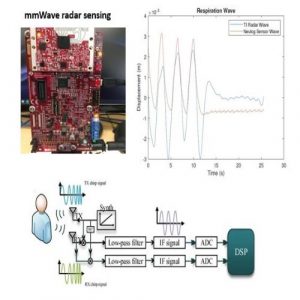Objectives #
Non-contact sensing for vital signs and human activities utilizing wireless signals has attracted a lot of attention in the last few years. Extensive research has been done using cameras and wireless technologies such as WiFi, acoustic waves, Ultra-wide band (UWB) and mmWave radars. The performance of vision-based solutions tends to degrade under poor light conditions and in presence of obstacles in environments. Privacy threat is another concern in deploying vision-based solutions in home or in personal vehicles. In contrast, RF sensing is advantageous in its ability to penetrate garments or walls, operate under different lighting and weather conditions, and better preserve people’s privacy. Despite successful research demonstrations, there remain significant gaps in practical adoption and deployment. Many challenges need to be addressed to handle the presence of multiple subjects, subject diversity and environmental interferences. The objective of this project is to develop robust non-contact sensing solutions to detecting vital signs and extracting high-level analytics of human activities in indoor and in-vehicle environments.
Participant #
- Bo Zhang (PDF)
- Wei Zhao (PHD)
- Suhan Shi (Intern)
- Boyu Jiang (MSc)
Research Thrusts #
1- Robust Vital Sign Monitoring using mmWave Radars
Overall, mmwave radars typically span 30GHz up to 300GHz with wavelength in the scale of millimeters. This implies range resolutions as high as 3cm. Additionally, the received reflected signals are suitable for detecting small-scale periodic movements such as those from respiration and heart beats.
We will utilize primarily two types of broadband technologies, namely, mmWave radar and UWB-based radar. The projects are expected to not only advance the state-of-the-art in algorithmic design for non-contact RF sensing but also develop proof-of-concept prototypes and demonstrative applications.




